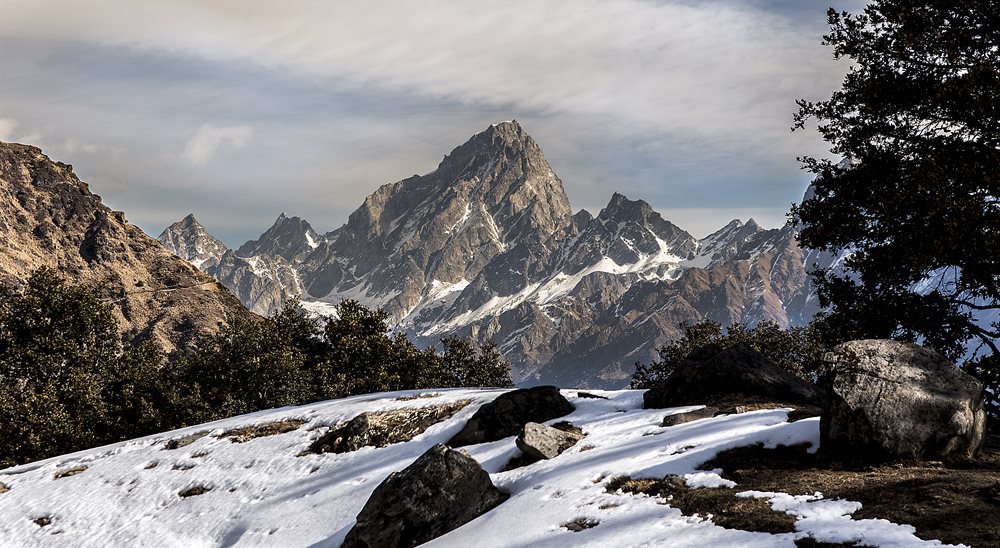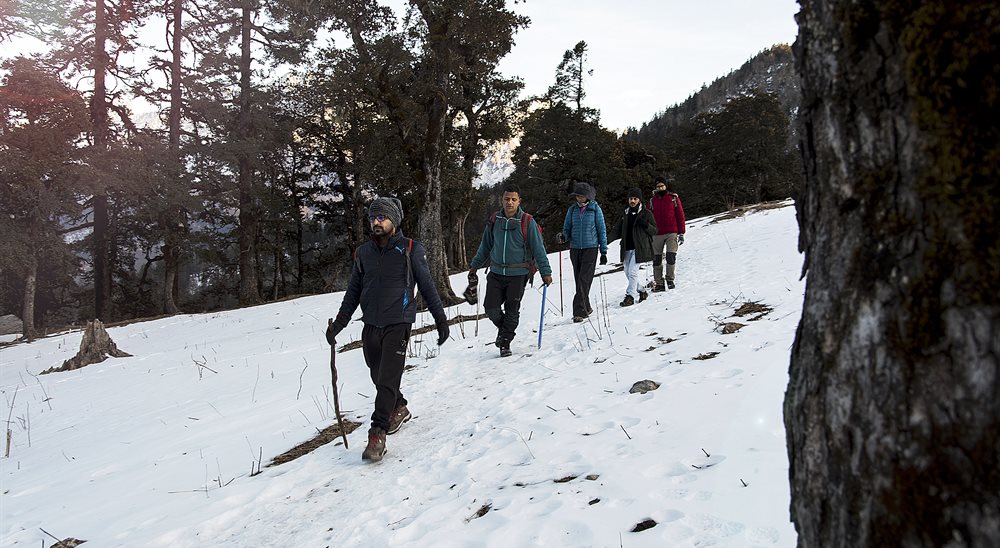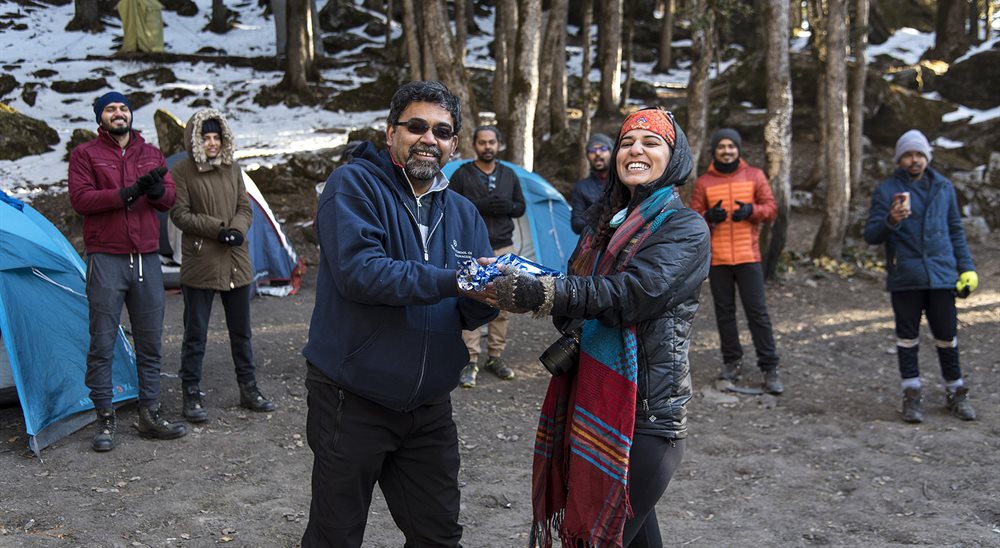views

Welcome to the captivating world of the Kuari Pass Trek, a breathtaking adventure nestled in the heart of the Garhwal Himalayas. Standing tall at an elevation of 4,264 meters, this magnificent pass offers an unparalleled opportunity to immerse yourself in the grandeur of the Himalayan peaks, including the majestic Nanda Devi Massif. Ranked among the top three treks in the region, alongside the Deoriatal and Sandakphu treks, the Kuari Pass Trek promises an unforgettable journey through nature's wonders.
Embark on this exhilarating trek through enchanting forests filled with Deodar and Oak trees, where you may even encounter the elusive footprints of Himalayan black bears and leopards. As you ascend, the trail unveils a tapestry of lush meadows, including the renowned Gorson Bugyal, offering panoramic vistas of the Himalayan Range. With its moderate difficulty level and well-crafted itinerary, the Kuari Pass Trek is an ideal introduction to the Himalayas for both seasoned trekkers and first-time adventurers alike.

Detailed Cost Breakdown
The cost of the Kuari Pass Trek can be broken down into several components, including the trek cost, accommodation fees, food and supplies, and transportation costs. Let's explore each aspect in detail.
Trek Cost
The price for the Kuari Pass Trek is typically quoted for a group of 16 people. The charges may vary for a tailormade private trek, and non-Indian trekkers may have to pay higher fees due to different permit costs.
Accommodation Fees
While the trek package covers accommodation costs during the trek itself, you may need to arrange separate accommodation before and after the trek. Several options are available, ranging from budget-friendly homestays to luxurious resorts, catering to different preferences and budgets.
Food and Supplies
- Meals on the Trek: All meals during the trek are included in the package. Vegetarian Indian food cooked by high-altitude chefs will be served, typically consisting of a five-course meal plan. Some trekkers have praised the quality and variety of the food, with delectable options like samosas, popcorn, pakoras, jalebi, and loki halwa.
- Water and Snacks: You will need to carry two 1-liter plastic water bottles or a 2-liter hydration pack to stay hydrated throughout the trek. It's also advisable to carry some personal snacks or energy bars for an extra boost during the trek.
Transportation Costs
- Pickup and Drop-off: The trek package typically does not include transportation from Dehradun to Joshimath and back. However, the organizers may arrange transport from Dehradun Railway Station on Day 1 of the trek, with the cost (approximately Rs. 6,500 per cab) to be shared among the trekkers and paid directly to the driver.
- Driving Distance and Duration:
- The distance from Dehradun to Joshimath is approximately 260 km, and the journey takes around 10 hours by road.
- The distance from Joshimath to Dhak village, the starting point of the trek, is about 12 km, which takes around an hour to drive.
- The return journey from Joshimath to Dehradun is approximately 293 km and takes around 10 hours.
It's important to note that transportation costs may vary depending on factors such as fuel prices, availability of vehicles, and any unforeseen circumstances. Additionally, you may need to budget for personal expenses, such as souvenirs or additional activities during the trek.
Essential Gear List
Clothing Essentials
Layering is crucial when trekking in the Himalayas to adapt to varying temperatures. Carry a base layer of synthetic, quick-drying T-shirts (2-3), preferably with collars to protect your neck and arms from sunburn. Pack a mid-layer of fleece jackets and sweaters that are lightweight and compact. For the outer layer, a padded jacket with a hood is recommended to shield against wind and cold. Additionally, include two pairs of trekking pants, one for wearing and one as a backup in case of rain or snow. Trekking pants with zippered cut-offs at the thighs are ideal for versatility.
Footwear and Accessories
Sturdy trekking shoes with good grip, ankle support, and the ability to handle snow are essential for the Kuari Pass Trek. Popular options include Decathlon's Trek 100 shoes, known for their comfort, durability, and waterproofing, as well as the MH500 and MH100 trekking shoes from Quechua. Sunglasses are crucial to prevent snow blindness caused by the reflection of UV rays on snow. A sun cap is mandatory to protect against headaches, sunstrokes, and dehydration. Synthetic hand gloves with waterproofing and a padded lining are recommended for gripping and warmth in snow.
Camping Gear
For the Kuari Pass Trek, you'll need a 50-60 liter backpack with good hip and shoulder support, as well as quick-access pockets. Trekking poles provide stability and reduce energy consumption, especially on steep ascents and descents. A headlamp or flashlight is essential for navigating campsites in the dark or during early morning starts. Carry a poncho or rain jacket to stay dry during unexpected downpours, and ensure your backpack has a built-in rain cover or a separate one to keep your belongings dry.
Other Important Items
Pack warm socks, including synthetic or woolen options, to keep your feet dry and comfortable. A sleeping bag is necessary for overnight stays in the mountains, providing warmth and comfort. Don't forget a first aid kit with medications prescribed by your doctor to address minor injuries, headaches, or altitude-related discomfort. Carry valid identification and trekking permits for smooth entry at checkpoints. Lastly, stay hydrated by carrying two 1-liter water bottles or a hydration pack, along with water purification tablets.
Comprehensive Packing List
Clothing
- Hiking boots (1 pair)
- Moisture-wicking socks (5 pairs)
- Quick-dry T-shirts (3)
- Long-sleeve hiking shirt (1)
- Hiking pants/shorts (2 pairs)
- Fleece jacket or sweater (1)
- Waterproof and windproof jacket
- Beanie or hat
- Gloves
- Sunglasses with UV protection
- Bandana or scarf
- Underwear and base layers (5 sets)
Trekking Gear
- Trekking poles
- Backpack (45-65 liters)
- Sleeping bag suitable for low temperatures
- Sleeping pad
- Tent (if not provided by tour company)
- Headlamp with extra batteries
- Reusable water bottle or hydration system
Personal Items
- Pocket knife or multi-tool
- Emergency whistle
- Personal locator beacon or satellite messenger (optional)
- Trekking or hiking map
- Compass or GPS device
- Portable phone charger/power bank
First Aid Kit
- Antiseptic wipes
- Antibacterial ointment
- Assorted bandages
- Gauze pads in various sizes
- Medical tape
- Moleskin or another type of blister treatment
- Ibuprofen (or another preferred pain-relief medication)
- Insect sting treatment
- Antihistamine for allergic reactions
- Non-stick pads
- Butterfly bandages
- Tweezers
- Safety pins
- Multitool
- First-aid cards that include instructions on how to use the items if you are not familiar
Group Equipment
- Stove and fuel (if needed)
Miscellaneous Items
- Camp sandals or lightweight shoes for camp
- Waterproof pack cover or dry bags
- Gaiters (in case of snow or wet conditions)
- Microspikes or crampons (if trekking in snow or ice)
- Trekking or hiking socks (2 extra pairs)
- Sunscreen (high SPF)
- Lip balm with SPF
- Insect repellent
- Emergency blanket or bivy sack
- Rain cover for backpack
- Valid ID and necessary permits
- Travel insurance documents
- Personal medications and prescriptions
- Emergency contact information
- Travel itinerary and important details
- Cash and small denominations
- Camera or smartphone for capturing memories
- Book or journal for leisure time
Kuari Pass Trek Itinerary

The Kuari Pass Trek typically spans over 4-5 days, allowing trekkers to immerse themselves in the stunning landscapes of the Garhwal Himalayas. Here's a day-by-day breakdown of the trek:
Day-by-Day Breakdown
Day 1: Arrive in Joshimath (2,040 m) and prepare for the trek.
Day 2: Drive from Joshimath to Tugashi and begin trekking to Tali (3,362 m).
Day 3: Embark on the challenging yet rewarding trek from Tali to Kuari Pass (3,814 m) and return to Tali.
Day 4: Descend from Tali to Auli (3,048 m) via the picturesque Gorson Bugyal meadow. Drive back to Joshimath.
Day 5: Depart from Joshimath, marking the end of your Kuari Pass Trek adventure.
Highlights and Key Locations
- Kuari Pass (3,814 m): The highlight of the trek, offering panoramic views of the Nanda Devi Massif, Dronagiri, Kamet, and other towering Himalayan peaks.
- Gorson Bugyal: A vast alpine meadow surrounded by snow-capped mountains, providing a breathtaking landscape.
- Tali Lake (3,500 m): A serene alpine lake with turquoise waters reflecting the majestic Nanda Devi peak, offering a rare and stunning view.
- Auli: A charming hill town known for its snow-draped landscapes and skiing opportunities.
Accommodation and Food
- Accommodation during the trek is typically in twin-sharing tents provided by the trekking company.
- Vegetarian meals, including Indian cuisine, are served throughout the trek, with the option of eggs on certain days.
- Trekkers with specific dietary restrictions or allergies should inform the trekking staff to accommodate their needs.
Logistical Considerations
- Trekkers may need to arrange transportation from Dehradun to Joshimath and back, with the option of shared cabs or private vehicles.
- Obtaining necessary trekking permits, such as the Nanda Devi Biosphere Reserve permit, is required for the Kuari Pass Trek.
- Hiring a local guide, while not mandatory, can provide valuable assistance with navigation, safety, and cultural insights.
- Proper trekking gear, including warm clothing, trekking poles, and appropriate footwear, is essential for a comfortable and safe experience.
By following this itinerary and considering the logistical aspects, trekkers can fully immerse themselves in the beauty of the Kuari Pass Trek while ensuring a well-planned and enjoyable experience.
Conclusion

After analyzing the Kuari Pass trek's highlights, challenges, and logistical considerations, one can appreciate the allure of this breathtaking Himalayan adventure. From the majestic Nanda Devi Massif to the serene Tali Lake and the vast expanse of Gorson Bugyal, the trek offers a tapestry of awe-inspiring natural wonders. Whether you're a seasoned trekker or a first-time explorer, the Kuari Pass Trek promises an unforgettable journey through some of the most captivating landscapes on Earth.
The memories forged on this trek will undoubtedly linger long after you've returned home, serving as a testament to the beauty and resilience of the Himalayas. If you're interested in embarking on this extraordinary adventure, contact Bikat Adventures to make your dream a reality. Embrace the opportunity to challenge yourself, immerse in nature's grandeur, and create memories that will last a lifetime.
FAQs
1. How challenging is the Kuari Pass Trek?
The Kuari Pass Trek features manageable inclines, although the altitude increases significantly on certain days. For example, on the first day, trekkers ascend from Dhak village at 2,090 meters to Tali Forest campsite at 3,362 meters, which is an elevation gain of approximately 1,300 meters.
2. What should I pack for the Kuari Pass Trek?
When packing for the Kuari Pass Trek, consider the following essentials:
- Clothing: The weather can vary significantly, with warm days and cold nights, so pack accordingly.
- Waterproof Jacket: The mountain climate can bring sudden rain or snow, making this an essential item.
- Trekking Pants and Thermal Wear: These are crucial for comfort and warmth throughout the trek.
3. Which trek is more suitable, Kuari Pass or Kedarkantha?
The choice between Kuari Pass and Kedarkantha depends on your trekking experience and preference for challenge. Beginners might prefer the Kedarkantha Trek for its accessibility, while those looking for a greater challenge may opt for the Kuari Pass Trek.
4. Is it possible to do the Kuari Pass Trek solo?
Yes, it is possible to trek Kuari Pass solo as hiring a guide is not mandatory. However, it is advisable only if you have substantial experience and knowledge of the Himalayas.





















Comments
0 comment